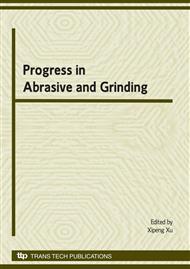p.123
p.131
p.137
p.143
p.149
p.157
p.165
p.177
p.185
Experimental Investigation of Temperatures in Diamond Wire Sawing Granite
Abstract:
The background temperatures in the sawing of granite with a diamond wire were measured by foil thermocouple. The influences of the measuring position in the cutting zone, cutting speed, feed rate and coolant on the temperature were investigated. The results indicated that the background temperature would be stable after a short-term rise. It was shown that the background temperature increased with cutting speed, but there was no obvious relationship between the background temperature and feed rate. The maximum background temperature appeared at the front part of the cutting zone at a lower feed rate. With an increase of feed rate, the background temperature at the middle of the cutting zone was the highest. The coolant had an obvious influence on the maximum background temperature.
Info:
Periodical:
Pages:
185-191
Citation:
Online since:
January 2009
Authors:
Keywords:
Price:
Сopyright:
© 2009 Trans Tech Publications Ltd. All Rights Reserved
Share:
Citation:


